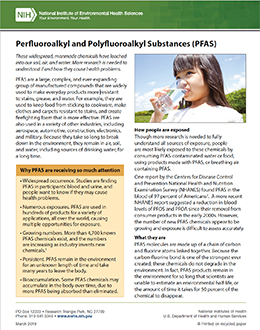Introduction

What Are PFAS?
PFAS are a large, complex, and ever-expanding group of manufactured chemicals that are widely used to make various types of everyday products. For example, they keep food from sticking to cookware, make clothes and carpets resistant to stains, and create firefighting foam that is more effective. PFAS are used in industries such as aerospace, automotive, construction, electronics, and military.
PFAS molecules are made up of a chain of linked carbon and fluorine atoms. Because the carbon-fluorine bond is one of the strongest, these chemicals do not degrade in the environment. In fact, scientists are unable to estimate an environmental half-life for PFAS, which is the amount of time it takes 50% of the chemical to disappear.
Research on two kinds of PFAS forms the basis of our scientific understanding about this group of chemicals. Perfluorooctanoic acid (PFOA) and perfluorooctane sulfonate (PFOS) were manufactured for the longest time, are the most widespread in the environment, and are the most well-studied. Although these two compounds are no longer made in the United States, chemical manufacturers have replaced them with alternative PFAS, such as GenX.

How Are People Exposed to PFAS?
These widespread, manmade chemicals have leached into our soil, air, and water. People are most likely exposed to these chemicals by consuming PFAS-contaminated water or food, using products made with PFAS, or breathing air containing PFAS. More research is needed to fully understand all sources of exposure, and if and how they cause health problems.
One report by the Centers for Disease Control and Prevention’s National Health and Nutrition Examination Survey (NHANES) found PFAS in the blood of 97% of Americans.1 A more recent NHANES report suggested a reduction in blood levels of PFOS and PFOA since their removal from consumer products in the early 2000s. However, the number of new PFAS chemicals appear to be increasing, and exposure is difficult to assess.
Fact Sheets
Perfluoroalkyl and Polyfluoroalkyl Substances (PFAS)
Why Be Concerned About PFAS?
Concerns about the public health impact of PFAS have arisen for the following reasons:
- Widespread occurrence. Studies find PFAS in the blood and urine of people, and scientists want to know if they cause health problems.
- Numerous exposures. PFAS are used in hundreds of products globally, with many opportunities for human exposure.
- Growing numbers. More than 4,700 PFAS exist, an increasing number as industry invents new forms of this type of chemical.2
- Persistent. PFAS remain in the environment for an unknown amount of time and may take years to leave the body.
- Bioaccumulation. Different PFAS chemicals may enter the food chain in various ways, gradually accumulating and remaining in a body over time—a process due to more intake than excretion of the chemicals.
What is NIEHS Doing?
The National Institute of Environmental Health Sciences and the National Toxicology Program are supporting research to better understand the potential health effects of exposure to PFAS.
What We Have Learned So Far
When looking for possible human-health effects of chemical compounds, it is important to understand that they are hard to study, especially with thousands of variations in PFAS chemicals. Much PFAS research has been supported or led by NIEHS.
The research conducted to date reveals possible links between human exposures to PFAS and adverse health outcomes. These health effects include altered metabolism,3 fertility,4 reduced fetal growth and increased risk of being overweight or obese,5 and reduced ability of the immune system to fight infections.6
While knowledge about the potential health effects of PFAS has grown, many questions remain unanswered. Therefore, NIEHS continues to fund or conduct research to better understand the effects of PFAS exposure.
National Toxicology Program
The National Toxicology Program (NTP) is an interagency testing program headquartered at NIEHS. In 2016, based on evidence from prior studies, NTP concluded that PFOA and PFOS were a hazard to immune system function in humans.7
NTP is leading multi-faceted toxicology studies to evaluate and identify the adverse effects of PFAS chemicals, such as:
- A systematic literature review of six PFAS chemicals—PFNA, PFHxS, PFHxA, PFDA, PFOS, PFBS—to determine whether they weaken the body’s response to vaccinations.
- Animal studies, including a two-year study on PFOA and 28-day studies on these seven PFAS chemicals: PFBS, PFHxS, PFOS, PFHxA, PFOA, PFNA, PFDA.
NIEHS-funded Research
NIEHS also awards many grants to external organizations, particularly research universities, across the U.S. to conduct PFAS studies, including:
- Time-sensitive studies such as PFAS exposures in residents near Colorado Springs whose water was contaminated with the PFAS known as perfluorohexane sulfonate (PFHxS), and contamination of the Cape Fear River in North Carolina by GenX.
- Long-term epidemiological studies of health effects of PFAS exposures, some beginning before birth, including a study on more than 300 children in the Faroe Islands.8
- In children’s environmental health research, a study examined associations between prenatal and childhood PFAS exposure with cognitive test results in children. The findings were inconsistent highlighting need for further research on the ways in which PFAS may act on the developing brain.9
- Another long-term study showed a link between PFAS exposure and increased risk of Type 2 diabetes in women.10
NIEHS Superfund Research Program (SRP)
SRP funds the search for practical applications to protect the public from exposures to hazardous substances. Examples include:
- The Sources, Transport, Exposure, and Effects of PFASs (STEEP) project, at the University of Rhode Island, is identifying sources of PFAS contamination, assessing human health effects, and educating communities on ways to reduce exposure.11
- The Michigan State Superfund Research Center is developing energy-efficient nanoreactors capable of breaking the carbon-fluorine bond that keeps PFAS from degrading.
- Scientists at the University of California, Berkeley, are working on options to contain aqueous film-forming foams used for firefighting, a major source of PFAS contamination.
- The Brown University Superfund Research Center has developed databases that exploit land use data to identify cities and towns at high risk for PFAS exposure.12
- Small Business Innovation Research (SBIR) grantee CycloPure, Inc., is developing new ways to remove hazardous PFAS from water.
- Another SBIR project by EnChem Engineering, Inc. is developing an innovative technology to speed up removal of PFAS at Superfund sites.
Why Research Collaboration Is Important
PFAS contamination is a complex issue that no organization can address alone. NIEHS and NTP are actively coordinating efforts with other government agencies on understanding the ways in which PFAS may affect human health.
- NIEHS participated at a federal information exchange meeting hosted by NIH in February 201813 and the PFAS National Leadership Summit hosted by EPA in May 2018.14
- NTP collaborates with EPA on the Responsive Evaluation and Assessment of Chemical Toxicity (REACT) program, which is developing a new approach to screen more than 100 PFAS to identify common and overlapping patterns of toxicity.
- NIEHS works closely with the U.S. Food and Drug Administration on PFAS-related food safety, and the Centers for Disease Control and Prevention on monitoring PFAS exposure levels.
- The Agency for Toxic Substances and Disease Registry consults with NIEHS on designing and conducting exposure assessments and health studies authorized by the National Defense Authorization Act for Fiscal Year 2018.

Public Health Impact of Research
Collectively, the work of NIEHS grantees, NTP, and their collaborators will help determine the toxicity of PFAS chemicals and potential adverse human health effects. Such data is valued by regulatory agencies and policymakers for informed decision making to help protect human health.
- Alternatives assessment helps ensure harmful chemicals are not replaced by equally harmful, but less well-studied, related compounds.
- Known as the Zurich Statement, NIEHS co-authored a commentary on PFAS15 calling for more collaboration among organizations researching, regulating, and using PFAS. It was developed at a November 2017 workshop in Zurich, Switzerland.
- Some state agencies review collective PFAS research findings to assess and evaluate the effects of these chemicals on human health in their communities.
Further Reading
Stories from the Environmental Factor (NIEHS Newsletter)
- Arsenic, Fluorescent Mice, and PFAS Among Topics at Tox Conference (October 2020)
- PFAS Research Shared at Federal Workshop Hosted by NIEHS (October 2020)
- Virtual Workshop Explores Newest PFAS Research (September 2020)
- PFAS Should Be Managed As a Single Class of Chemicals, Experts Say (August 2020)
- Canine Companions Shed Light on Chemicals and Disease (July 2020)
- Mauge-Lewis Researches Replacement PFAS in Firefighting Foams (May 2020)
- GenX Affects Function of Proteins That Protect the Brain (April 2020)
- Replacement Chemicals May Put Pregnancies at Risk (February 2020)
- PFOA Evaluated for Cancer Links by NTP Expert Panel (January 2020)
- Chemical Used in Sunscreen Analyzed for Potential Carcinogenicity (January 2020)
- North Carolina Scientists, Policymakers Take on PFAS (December 2019)
- PFAS Workshop Kicks off National Academies Initiative (November 2019)
Additional Resources
- Agency for Toxic Substances and Disease Registry
- Centers for Disease Control and Prevention
- FDA Statement (June 11, 2019) - Describes scientific work to understand PFAS found in food that Americans consume and findings from recent FDA surveys
- NIH News in Health: Making a Healthier Home: Cast Toxins from Your Living Space (69KB) - NIH article outlining how people can limit their exposure to potentially toxic chemicals in their day-to-day lives.
- Perfluorochemicals (PFCs)
- PFAS Collection - A selection of high-impact articles and reviews published in the journal Environmental Health Perspectives on the prevalence and accumulating health effects associated with PFAS exposure in humans and mouse models.
- PFAS Contamination Map - A nationwide map of PFAS contamination created by the Environmental Working Group (EWG)
- Scientists Dig Into Hard Questions About The Fluorinated Pollutants Known As PFAS - NPR story featuring comments on PFAS by NIEHS and NTP Director Linda Birnbaum, Ph.D.
- U.S. Environmental Protection Agency - Technical Fact Sheet
Related Health Topics
- Lewis RC, Johns LE, Meeker JD. 2015. Serum Biomarkers of Exposure to Perfluoroalkyl Substances in Relation to Serum Testosterone and Measures of Thyroid Function among Adults and Adolescents from NHANES 2011–2012. Int J Environ Res Public Health. 12(6): 6098–6114. [Abstract Lewis RC, Johns LE, Meeker JD. 2015. Serum Biomarkers of Exposure to Perfluoroalkyl Substances in Relation to Serum Testosterone and Measures of Thyroid Function among Adults and Adolescents from NHANES 2011–2012. Int J Environ Res Public Health. 12(6): 6098–6114.]
- Hearing on the Federal Role in the Toxic PFAS Chemical Crisis. [Available Hearing on the Federal Role in the Toxic PFAS Chemical Crisis.]
- Liu G, Dhana K, Furtado JD, Rood J, Zong G, Liang L, Qi L, Bray GA, DeJonge L, Coull B, Grandjean P, Sun Q. 2018. Perfluoroalkyl substances and changes in body weight and resting metabolic rate in response to weight-loss diets: a prospective study. PLoS Med 15(2):e1002502. [Abstract Liu G, Dhana K, Furtado JD, Rood J, Zong G, Liang L, Qi L, Bray GA, DeJonge L, Coull B, Grandjean P, Sun Q. 2018. Perfluoroalkyl substances and changes in body weight and resting metabolic rate in response to weight-loss diets: a prospective study. PLoS Med 15(2):e1002502.]
- Bach CC, Vested A, Jorgensen K, Bonde JP, Henriksen TB, Toft G. 2016. Perfluoroalkyl and polyfluoroalkyl substances and measures of human fertility: a systematic review. Crit Rev Toxicol. 46(9):735-55. [Abstract Bach CC, Vested A, Jorgensen K, Bonde JP, Henriksen TB, Toft G. 2016. Perfluoroalkyl and polyfluoroalkyl substances and measures of human fertility: a systematic review. Crit Rev Toxicol. 46(9):735-55.]
- Braun J. Early-life exposure to EDCs: role in childhood obesity and neurodevelopment. 2017. Nat Rev Endocrinol. 13(3):161–173. [Abstract Braun J. Early-life exposure to EDCs: role in childhood obesity and neurodevelopment. 2017. Nat Rev Endocrinol. 13(3):161–173.]
- Kielsen K, Shamim Z, Ryder LP, Nielsen F, Grandjean P, Budtz-Jorgensen E, Heilmann C. 2016. Antibody response to booster vaccination with tetanus and diphtheria in adults exposed to perfluorinated alkylates. J. Immunotoxicol. 13(2):270-3. [Abstract Kielsen K, Shamim Z, Ryder LP, Nielsen F, Grandjean P, Budtz-Jorgensen E, Heilmann C. 2016. Antibody response to booster vaccination with tetanus and diphtheria in adults exposed to perfluorinated alkylates. J. Immunotoxicol. 13(2):270-3.]
- Sept. 2016. Monograph on Immunotoxicity Associated with Exposures to PFOA and PFOS. Research Triangle Park, NC: National Toxicology Program [Accessed 25 February 2019]. [Available Sept. 2016. Monograph on Immunotoxicity Associated with Exposures to PFOA and PFOS. Research Triangle Park, NC: National Toxicology Program [Accessed 25 February 2019].]
- Grandjean P, Andersen EW, Budtz-Jørgensen E, Nielsen F, Mølbak K, Weihe P, Heilmann C. 2012. Serum vaccine antibody concentrations in children exposed to perfluorinated compounds. JAMA 307(4):391-7. doi: 10.1001/jama.2011.2034 [Abstract Grandjean P, Andersen EW, Budtz-Jørgensen E, Nielsen F, Mølbak K, Weihe P, Heilmann C. 2012. Serum vaccine antibody concentrations in children exposed to perfluorinated compounds. JAMA 307(4):391-7. doi: 10.1001/jama.2011.2034]
- Harris MH, Oken E, Rifas-Shiman SL, Calafat AM, Ye X, Bellinger DC, Webster TF, White RF, Sagiv SK. 2018. Prenatal and childhood exposure to per- and polyfluoroalkyl substances (PFASs) and child cognition. Environ Int 115: 352-369. [Online 2018 Apr 26] [Abstract Harris MH, Oken E, Rifas-Shiman SL, Calafat AM, Ye X, Bellinger DC, Webster TF, White RF, Sagiv SK. 2018. Prenatal and childhood exposure to per- and polyfluoroalkyl substances (PFASs) and child cognition. Environ Int 115: 352-369. [Online 2018 Apr 26]]
- Sun Q, Zong G, Valvi D, Nielsen F, Coull B, Grandjean P. 2018. Plasma Concentrations of Perfluoroalkyl Substances and Risk of Type 2 Diabetes: A Prospective Investigation among U.S. Women. Environ Health Perspect. 126(3):037001. [Abstract Sun Q, Zong G, Valvi D, Nielsen F, Coull B, Grandjean P. 2018. Plasma Concentrations of Perfluoroalkyl Substances and Risk of Type 2 Diabetes: A Prospective Investigation among U.S. Women. Environ Health Perspect. 126(3):037001.]
- STEEP: Sources, Transport, Exposure, & Effects of PFASs. [Accessed 25 February 2019] [Available STEEP: Sources, Transport, Exposure, & Effects of PFASs. [Accessed 25 February 2019]]
- Guelfo JL, Adamson DT. Evaluation of a national data set for insights into sources, composition, and concentrations of per- and polyfluoroalkyl substances (PFASs) in U.S. drinking water. 2018. Environ Pollut. 236:505-513. [Online 1 May 2018] [Abstract Guelfo JL, Adamson DT. Evaluation of a national data set for insights into sources, composition, and concentrations of per- and polyfluoroalkyl substances (PFASs) in U.S. drinking water. 2018. Environ Pollut. 236:505-513. [Online 1 May 2018]]
- Lenox K. Federal Agencies Exchange PFAS Updates. NIEHS Environmental Factor. 2018, March. [Internet Lenox K. Federal Agencies Exchange PFAS Updates. NIEHS Environmental Factor. 2018, March.]
- U.S. Environmental Protection Agency. EPA PFAS National Leadership Summit and Engagement. May 22-23, 2018. [Internet U.S. Environmental Protection Agency. EPA PFAS National Leadership Summit and Engagement. May 22-23, 2018.]
- Ritscher A, Wang Z, Scheringer M, Boucher JM, Ahrens L, Berger U, Bintein S, Bopp SK, Borg D, Buser AM, Cousins I, DeWitt J, Fletcher T, Green C, Herzke D, Higgins C, Huang J, Hung H, Knepper T, Lau CS, Leinala E, Lindstrom AB, Liu J, Miller M, Ohno K, Perkola N, Shi Y, Smastuen Haug L, Trier X, Valsecchi S, van der Jagt K, Vierke L. 2018. Zurich statement on future actions on per- and polyfluoroalkyl substances (PFASs). Environ Health Perspect 126(8):84502. [Abstract Ritscher A, Wang Z, Scheringer M, Boucher JM, Ahrens L, Berger U, Bintein S, Bopp SK, Borg D, Buser AM, Cousins I, DeWitt J, Fletcher T, Green C, Herzke D, Higgins C, Huang J, Hung H, Knepper T, Lau CS, Leinala E, Lindstrom AB, Liu J, Miller M, Ohno K, Perkola N, Shi Y, Smastuen Haug L, Trier X, Valsecchi S, van der Jagt K, Vierke L. 2018. Zurich statement on future actions on per- and polyfluoroalkyl substances (PFASs). Environ Health Perspect 126(8):84502.]
This content is available to use on your website.
Please visit NIEHS Syndication to get started.to Top



